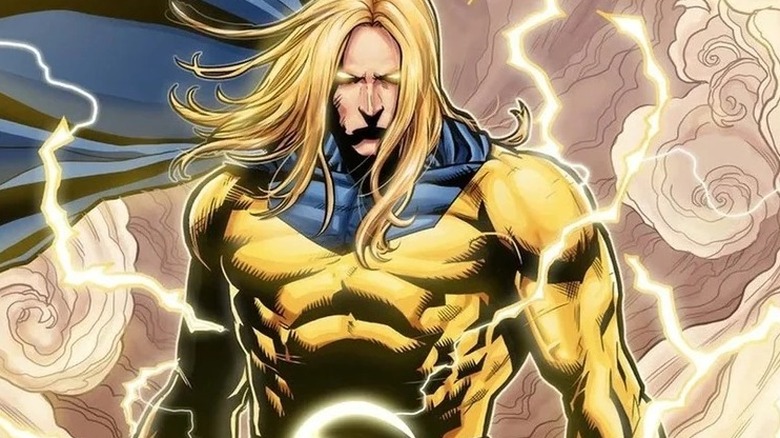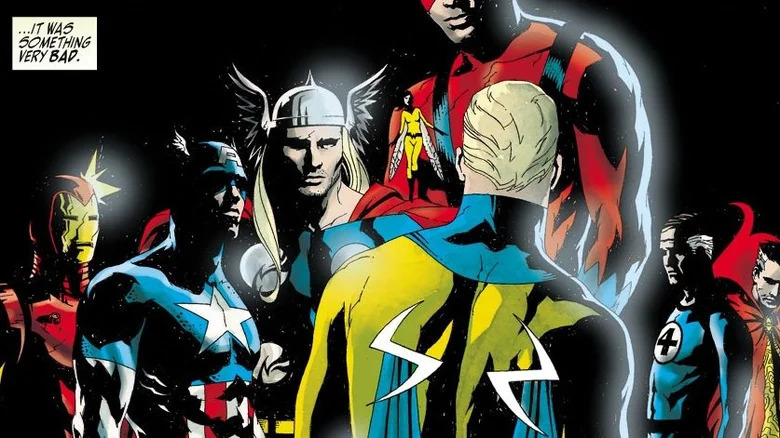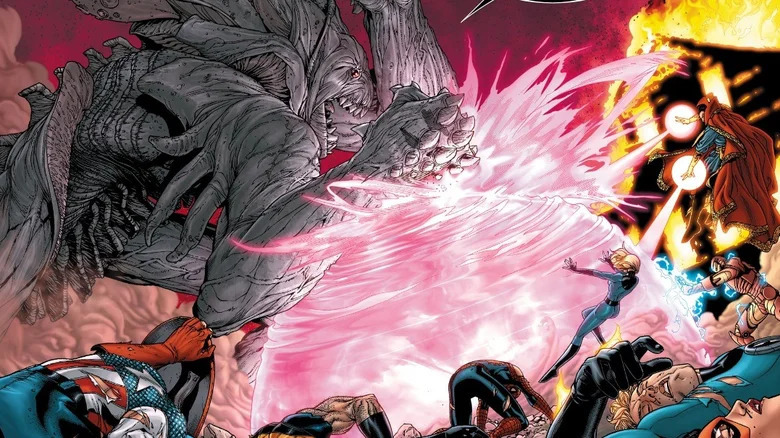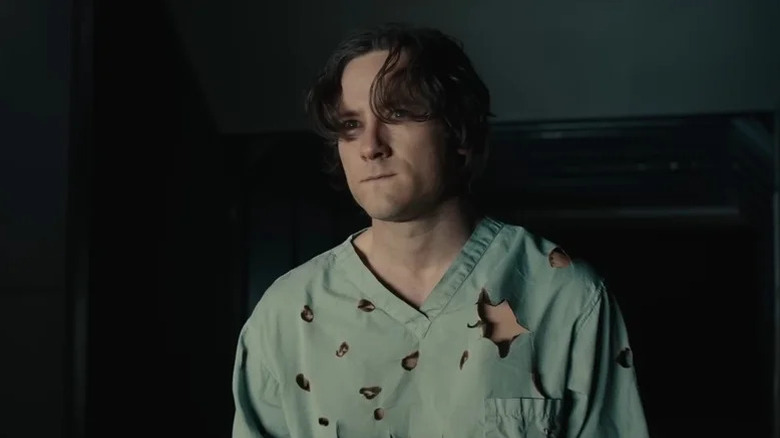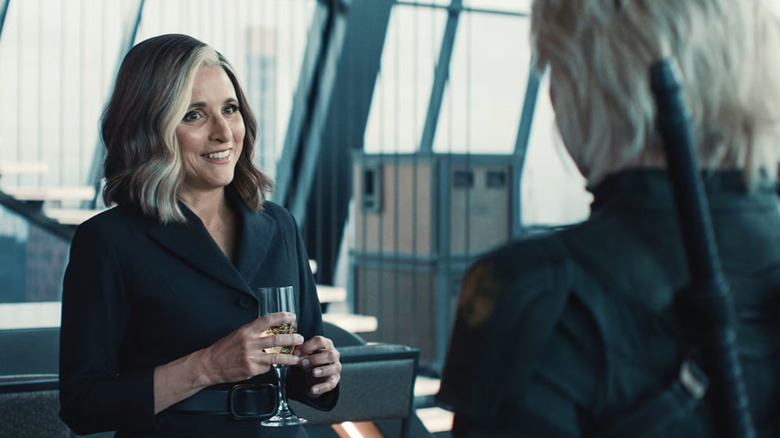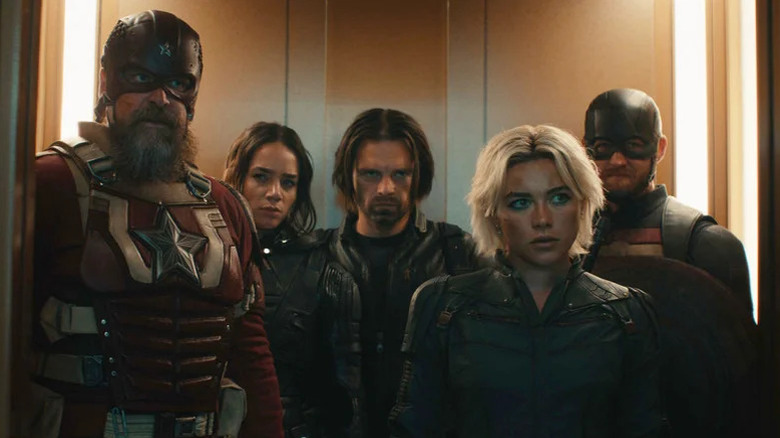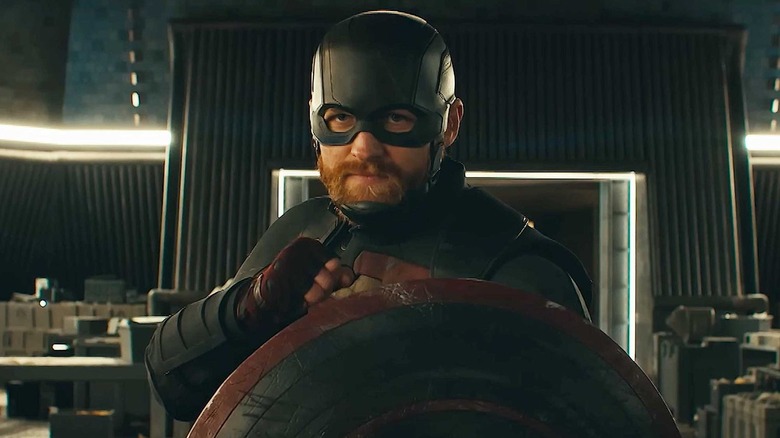Who Is Marvel's Sentry? The Thunderbolts* Villain Explained
We may receive a commission on purchases made from links.
"Thunderbolts*" brings back the B-list villains and second-string heroes of the Marvel Cinematic Universe, testing if this temperamental group of mercenaries can become heroes. But there's another new face thrown in: Robert Reynolds/The Sentry (Lewis Pullman). Created as a superhero who could be all the Avengers in one, Bob has a dark side named the Void. The Sentry/The Void is easily one of the best villains a recent Marvel movie has offered, but how does the adaptation live up to the original?
The Sentry is a relatively recent creation, debuting in 2000 and created by Paul Jenkins, Jae Lee, and Rick Veitch. He's one of the countless Superman clones across comics; he has the same powerset (flight, super strength, energy blasts, etc.), the flowing cape and S-insignia, he gets his powers from the sun (hence his golden costume and nickname, "The Golden Guardian of Good"), and he even boasts the classic alliterative secret identity (think "Clark Kent"). As in the film, Mr. Reynolds is not all good. Afflicted with a personality disorder since he got his powers, his archenemy is his own soul-devouring shadow self.
Now that Bruce Banner (Mark Ruffalo) is the Hulk full-time and Wanda Maximoff (Elizabeth Olsen) was seemingly (?) crushed beneath Mount Wundagore, the Sentry easily slots in as the MCU's new Jekyll & Hyde anti-hero. Bob's back-and-forth between hero and villain, and recurrent amnesia, are in line with the Sentry's comic history.
What are the Sentry's powers?
On the surface, Sentry's powers are the same as Superman's. He can fly, he's super-strong and fast, he has X-ray vision, his skin is as strong as steel, and he's typically associated with the sun; the Sentry is often drawn with a golden glow and sometimes blasts golden energy, akin to Superman's heat vision. The Sentry has even flown into the sun itself and returned from that. (He doesn't literally absorb power from solar energy the way that Superman does, though.)
But in truth, the Sentry's powers extend beyond just those typical superheroic ones. He's near omnipotent because he can manipulate reality. This means the world is at his fingertips, and he can essentially have any power he can imagine. The Void does not have a single pinned-down appearance, sometimes manifesting as a mirror image of the Sentry, or a black shadow beast, or a tumor-like monster, because it can control reality and itself.
The "Thunderbolts* take on the Void has a simple, elegant, and creepy design: Bob's silhouette, completely black except for two tiny white lights as his eyes. This design shows how the Void is Bob's shadow self and the black void of nothingness that his depression represents to him.
The movie Sentry's powers are largely the same as the comic version: flight, strength, speed, etc. He also shows some psychic powers: telekinesis in his first fight with the Thunderbolts and telepathy when he first touches Yelena (Florence Pugh). The telepathy is how the Void's reality-shifting manifests in the movie; he creates a black cloud that spreads across New York and seemingly disintegrates anyone who touches it. In truth, it only brings them into the Void's dimension, where they experience their worst memories and fears.
The comic book history of Thunderbolts* villain Sentry
The Sentry comes out of "Marvel Knights," an imprint started in the late 1990s for writers and artists to craft relatively more creator-driven and mature stories with Marvel's stable of characters. "The Sentry" was a miniseries by Jenkins and Lee about the greatest superhero no one had ever heard of.
Bob Reynolds is portrayed as a miserable middle-aged man with memories of being The Sentry, but no one else recalls them. The first issue leaves it ambiguous if he's delusional or not — until he starts flying in the last panel. Reynolds then visits other heroes of the Marvel Universe (the Fantastic Four, the Hulk, Spider-Man, and the X-Men) and speaks to them as old friends even though they're unable to remember him.
You see, Reynolds senses The Void is returning and they must marshal a defense. The twist, that Sentry and The Void are one and the same, comes in the final issue, "The Sentry Vs. The Void" #1. Discovering the truth of the Void, and that he and his superhero friends agreed to erase the Sentry to stop the villain, Bob accepts his "normal life" and everyone forgets about him again. The ending, though, suggests his memory of the Sentry is still in there somewhere.
"The Sentry" is a riff on Alan Moore's "Miracleman," also about a middle-aged mediocrity discovering long-lost memories of being a superhero. To sell the illusion of the Sentry having always been part of the Marvel universe, the series also includes flashbacks done in different art styles; the Sentry's origin story (he ingests a modified super soldier serum) and his teaming up with the Avengers to fight The Void in issue #1, for instance, are drawn in the style of Jack Kirby. This blocky, classical style contrasts with Lee's darkly shaded, sharper-edged art.
Sentry and The Void returned in New Avengers
"The Sentry" could've easily just been a one-off story, but it wasn't the end for Robert Reynolds after all.
The most important Marvel Comics writer of the 2000s was Brian Michael Bendis (he jumped ship to the Distinguished Competition in 2017, but that's another story). After knocking it out of the park on titles like "Ultimate Spider-Man," "Alias," and "Daredevil" thanks to his crime storytelling instincts and David Mamet-esque dialogue, he was charged with rebooting the Avengers in 2004.
Bendis' "New Avengers" opened with "Breakout" (drawn by David Finch); Electro breaks into the supervillain prison The Raft and frees all the inmates. The New Avengers form out of the first responders (Captain America, Iron Man, Spider-Man, Luke Cage, and Spider-Woman — Daredevil declines, and the sixth spot is filled by a late-to-the-party Wolverine).
"New Avengers" issue #1 ends by revealing Sentry is imprisoned in The Raft, having turned himself in for seemingly killing his wife Lindy. After some imploring, he uses his powers to save Daredevil and Foggy Nelson from Carnage (he flies the villain up into the atmosphere and rips him in half) but jets off after the riot is over.
The second "New Avengers" arc, titled "The Sentry," features the team tracking down Sentry and relearning his hidden existence — as far as they know, the Sentry is only a comic book character created by Paul Jenkins (talk about meta). It turns out Reynolds didn't kill his wife, but convinced himself he did to put another psychic block on his powers.
While the Avengers fight the shapeshifting Void, the X-Men's Emma Frost enters Reynolds' mind for telepathic therapy. It's revealed that the psychic mutant Mastermind erased the world's memories of the Sentry and planted the idea of The Void in Reynolds' head to restrain him; he wouldn't use his powers if he thought the cost was a terrible supervillain's existence.
How the MCU Sentry works as the Thunderbolts* villain
"Thunderbolts" wisely doesn't get anywhere near as meta with its depiction of Sentry as his introductory series or "New Avengers" did. A two-hour blockbuster ensemble is packed enough as is. Plus, the MCU is already dealing with problems of over-complication. Rewriting its own history so the Sentry was there the whole time and everyone forgot? That's a whole other headache that should stay in the comics.
The "Thunderbolts*" take on Sentry hews closer to his depictions in the Bendis "Avengers" saga, especially "Dark Avengers" (more on that soon). In the movie itself, he's a resonant villain. "Thunderbolts*" is about depression; the opening of the film features Yelena narrating that she's listless and finding no joy in her life or secret agent job. In the words of Buffy Summers, she's going through the motions. Bob has the same disease as Yelena, and the Void represents the dark voice every depressed person hears sometimes, whispering that nothingness would be preferable. Yelena and Bob overcome the Void and what he represents, together. In "Thunderbolts*," the action serves a purpose beyond spectacle.
Additionally, Pullman is a great actor and shows his earned stripes during "Thunderbolts*." An everyman with a darker side is exactly the kind of role he excels at — see "Bad Times at the El Royale," wherein he plays the manager of the eponymous hotel and a fella whose polite, timid demeanor belies his history of violence.
In Pullman, Marvel found an actor who can pull off the well-meaning but confused Bob, the confident and well-meaning but unstable Sentry, and the pure-evil Void.
Dark Avengers set the stage for Thunderbolts*
"Dark Avengers" was a "Thunderbolts" series in the clothing of the Avengers — and offers the greatest blueprint for how the MCU has used the Sentry so far. Halfway through the film, CIA Director Valentina Allegra De Fontaine (Julia Louis-Dreyfus) learns that Bob survived her organization's Project: Sentry experiments. She decides she can manipulate him into the "hero" (read: weapon) she wanted.
In "Thunderbolts*," Val is playing the role that Norman Osborn did in the comics; a corrupt intelligence official manipulating the Sentry. "Dark Avengers" issue #3 opens with a flashback of Norman helping Reynolds with his still-present mental issues. (After all, the Green Goblin has experience managing a split personality.) It's not out of empathy, though. Norman wants the Sentry as a human weapon he can control; "Dark Avengers" shows how Norman is playing with a time bomb by doing this. This culminates in the event series "Siege," when Osborn unleashes Sentry on Asgard. Compare how Val's attempt to rein in the Sentry only sees the Void opening up across Manhattan.
Bendis played around with the Sentry's origin too, rewriting Reynolds' past so he was a drug addict who got his powers because he found the serum during a break-in. As for The Void? The story suggests that it's literally the Biblical Angel of Death possessing Robert. This fits with the villainous turn the Sentry makes in "Siege," but it also reflects how the character and his history were left too messy by endless revisions. Hopefully, the MCU won't complicate its Sentry too much after "Thunderbolts*."
The Thunderbolts can't beat Sentry in a fight
"Thunderbolts*" does not dissuade comparisons to "Suicide Squad" by featuring the Void as the villain. David Ayer's "Suicide Squad" featured a bunch of low-powered villains going up against a cosmic horror way out of their league (the Enchantress, played by Cara Delevigne). Then James Gunn's "The Suicide Squad" did the same thing with its big bad, the enormous, parasite-spawning alien Starro the Conqueror.
Sentry is a villain in the same vein: way more powerful than the antiheroes, to the point you'll wonder how they can defeat him. The Thunderbolts are a team of mercenaries and soldiers. Their main skills are "shoot guns really well." Even the strongest ones, like Bucky (Sebastian Stan) and Red Guardian (David Harbour), are still only on Captain America's (Chris Evans) level.
When the Thunderbolts attempt to arrest Val and she sics the Sentry on them, they're hopelessly outmatched. He throws them around, ripping Bucky's arm off, and they wisely retreat. Then, it gets even worse when the Void pops out. What can a Black Widow like Yelena Belova do against a demigod? Give him a hug.
The Void's defeat comes from an internal battle, where the Thunderbolts enter Void's dimension to rescue Bob and encourage him that he's better than his worst self and negative thoughts. "Thunderbolts*" is a film about flawed people finding redemption together, and just punching out the bad guy would undermine that message. Bob/Yelena's intertwined arcs and the movie's themes of overcoming depression are very simple ("The End of Evangelion," "Thunderbolts*" is not), but it's still effective.
Will Sentry return after Thunderbolts*?
Bob survives the events of "Thunderbolts*" and is there at the end when the team becomes New Avengers. He's not totally in control (because the Void will never totally go away), but for the moment, his demons are abated. Lewis Pullman is also among the cast members announced for "Avengers: Doomsday" alongside his Thunderbolts/New Avengers teammates like Pugh, Harbour, etc.
In the "Thunderbolts*" post-credits scene, set 14 months later, Bob is still with the New Avengers. But despite Red Guardian's support, Bob refuses to activate his powers because "[he] can't be Sentry without the other side."
I could easily imagine a story where Sentry is kept in reserve as a last resort weapon against Doctor Doom (Robert Downey Jr.), but that only awakens the Void. The Void could then side with, or be used by, Doom as a weapon against the Sentry's fellow heroes.
Then there's the sequel to "Doomsday," "Avengers: Secret Wars." No word on if Pullman/Sentry will be in that (and Sentry had no role to play in "Secret Wars" in the comic), but it's a definitive possibility.
The Void almost wasn't the villain in the Thunderbolts*
Despite how out of the Void's league the Thunderbolts are, he fits as the movie's villain. But the movie almost featured a different villain entirely, one nestled onto the team: John Walker/U.S. Agent (Wyatt Russell). In an interview with Screen Rant, "Thunderbolts*" co-writer Eric Pearson explained how Walker functioned as a villain in the film's early drafts.
"The original drafts of this had John Walker as the punching villain at the end. The idea was that part of Val's manipulation was that she had told him that his [super-soldier] serum was wearing off, and she was doing these medications to keep him going. In reality, he was a time bomb; a Hulk kind of thing."
Pearson added that the film still would've ended with the Thunderbolts bringing John back down to Earth: "From the beginning of this, it was like, 'I want to end our third act fight with a hug." To get to that point, they decided to use a villain who the Thunderbolts could never hope to beat by punching. That's not John Walker.
Based on Pearson's comments, the overall movie didn't change that much. Val still would've been manipulating the character who becomes the main villain (but John instead of Bob), and the rest of the Thunderbolts would've calmed him down.
But honestly? Walker should be a villain. That's what his first appearance in "Falcon and the Winter Soldier" was building to. He's everything Captain America shouldn't be; the "perfect" jingoistic soldier. In episode 4, he kills an unarmed and fleeing man in cold blood. Then, the show chickens out and gives him a last-minute redemption. Seeing him get a spot on the New Avengers and exchanging witless banter with all the others in that "Thunderbolts*" post-credits scene? Gross.
How Spider-Man: No Way Home changed Sentry's story
Speaking to Marvel.com after the release of "Thunderbolts*," director Jake Schreier explained that there's another reason that the film didn't depict the Sentry as the hero the world forgot. "Spider-Man: No Way Home" had already done something similar, where Peter Parker (Tom Holland) had Doctor Strange (Benedict Cumberbatch) cast a spell so the whole world would forget about Peter Parker.
"Obviously, we couldn't tell that same story," said Schreier. "Thanks, Jon [Watts, director of 'No Way Home']." Instead, Schreier and co. decide to zero in on other pieces of the Sentry's story as told in the original comics. Schreier said he consulted with Paul Jenkins, who always thought of the Sentry's story as being about a man struggling with himself.
"[Jenkins] would talk about it as a parable for mental health and this idea of an equal amount of good and evil. But when I read Sentry in those comics, there is this level of hubris that he has, and it feels like people around him are getting a little concerned about it. I thought it was so resonant."
As for the meta aspects of the Sentry's character, Schreier found a way to touch on that without tangling up Marvel continuity.
"So much of the meta of the movie is trying to create a superhero thought, 'Well, that's what [Marvel] does.' So, in that scene where Bob is learning to use his powers and they're building a suit behind him, all of that stuff comes from our actual costume department. And there's a 3D printer from [property master] Russell Bobbitt. We're doing the same thing that Val is doing in the movie, so that was our little nod to the meta idea of how we represent superheroes."
With the positive reception of "Thunderbolts*" so far, it looks like Schreier succeeded where Val failed and made the Sentry into a superhero people can love.
"Thunderbolts*" is playing in theaters.
